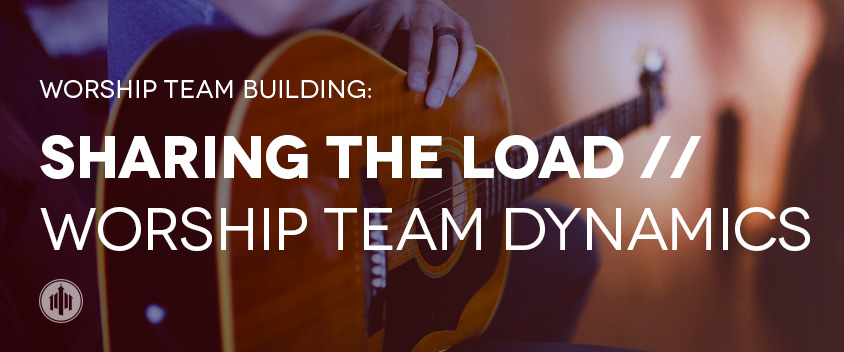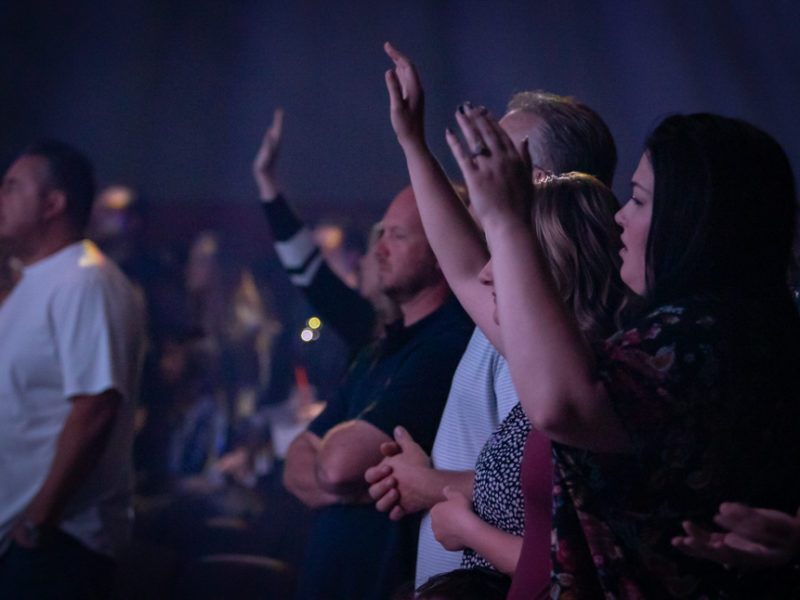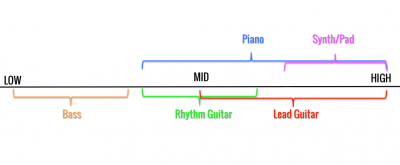
In the last post I wrote for this series I hit on dynamics between multiple guitarists. This post will take the same principles and spread it out even wider to the full band. The whole idea of sharing the load is about having a team mentality and working together in order to compliment one another musically, so that the songs we lead in our services both accomplish the purpose of leading others in worship and doing it in a way that’s well thought out musically and executed well.
There is one big thing to remember when playing together in a band; everyone shouldn’t be playing the same thing the whole time. I’ve played in and have seen multiple bands where everyone is playing the same chords, on the same mid-low end of their instruments. This creates that, “this doesn’t sound bad, but this doesn’t sound good” sound. It creates a muddy sound; a sound that lacks dynamics.
What I have found is that in a lot of worship band settings the musicians are used to playing and practicing at home by themselves. So they play the songs they enjoy in the full sounding mid-low range, which sounds great by yourself. Then those same musicians come together and put all their full mid-low sounds together, and it becomes a mess with everyone stepping on one another’s toes. This is where the idea for this blog series of sharing the load came from. So let’s spread the load of dynamics throughout the band as a whole and share this musical load.
Most worship bands these days have a rhythm guitar (acoustic or electric), lead guitar (typically electric), keys, bass, drummer, and vocalists. That’s the most popular line-up I’ve seen, so that’s what I’ll use a reference point in this post. Actually I’m even going to leave the drummer and vocalists out because the muddiness I’m dealing with for the most part comes from the instruments playing the notes/chords.
The image below is how I visualize worship team dynamics. This is not in concrete or anything of the sort, but this for the most part is what I shoot for when I arrange songs.
The Low End
As you can see, the only instrument who has their own space is the bass. I have our bassists hold down the low end, they own that space. If any other instrument hits those same low-end frequencies more times than not it doesn’t sound good, it just sounds confusing. This problem seems to arise most often if we use synth or pad settings on the keyboard. The pad over takes the low-end rendering the bass hidden, and the over all sound becomes mud.
To prevent that problem we try to have synth/pad play more in between mid to high. This typically allows the synth to stand out, but the rest of the band isn’t lost in the background. Again, this isn’t always the case, you have to take a lot of these things on a song to song basis. If the synth needs to be more mid to low, the bassist may want to think about playing on the D & G string rather than E & A.
The Mids
The next instruments on the spectrum are the piano (Piano can be rhythm or lead in the same exact song, so that instrument expands over much of the spectrum) and the rhythm guitar. I have these instruments more in the mid section, but can lean more low-mid or mid-high (taking into account capo positions and all that good stuff). These rhythm instruments are what drive the song. I keep them in the mid section because that places them in a pretty neutral position among the other instruments, offering nice tone and good rhythm but not overpowering. In many of the band line-ups I have seen the worship leader is typically playing acoustic guitar or piano. Playing in the mid range makes the leaders life easier because generally the easier chord positions are there (at least for guitarists), not that worship leaders can’t play complicated chords but I know for me, I’d like to think as little as possible if I’m leading (about chord changes that is).
The Highs
Then there are the lead instruments. When I say lead I don’t mean the worship leader but rather the instrument playing melody riffs or adding accents over the rhythm instruments. I prefer to keep the lead instruments playing towards the mid to higher end of things. That high-end sound sits nicely over the mids and lows and really stands out; which is exactly what you want with lead parts. Just to clarify, when I say high I don’t mean always 12th fret and up, I just mean using more of the G, B, and High E strings instead of the Low E, A, and D strings. And for keyboard players I mean playing above that middle C range. Keeping the lead instruments in the higher range keeps them from just blending in with the rest of the rhythm section. Chris has some great advice for chord shapes here.
Instrumental Breaks
On instrumental breaks knowing who the lead instrument is is very important because the rest of the band should be the foundation underneath that lead instrument. There is nothing more painful then having an instrumental break and everyone thinks its time for their solo moment. Pick one instrument to be that lead, and everyone should support.
For more inexperienced bands that means just saying on the chords while the lead takes it away. Perhaps for musicians with a little more experience the band can play parts that compliment, though they may not be just the basic chords. (E.g. Alternate bass line, harmonizing piano and the guitar to share the lead) Instrumentals are a time to let the words of the songs soak in, and give people some time to relish in what they’ve just proclaimed in song. The last thing we want as worship leaders is to distract from that, especially from overplaying.
Keep in mind that sharing the load can be done in many different ways. I’ve shown one example and one frame of thought. Let this be a starting point, but don’t think this is the only way. Different songs dictate different dynamics, be mindful of who is playing what and make sure to share the load together.



